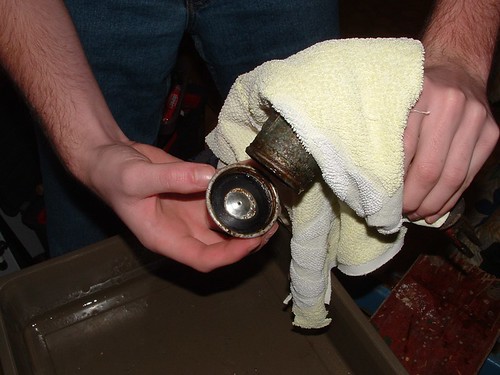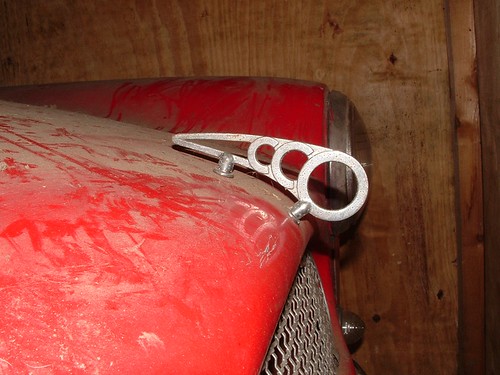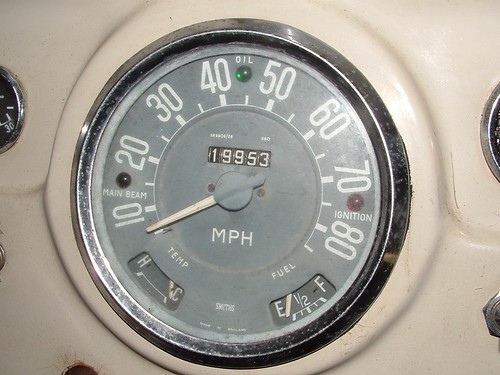During February I managed a weekend away to try and discover where the brake system on Reg was leaking fluids from. After working on the master cylinder I was fairly sure that there were no leaks coming from there, so that left the rest of the system to investigate. First job on the cards was to get Reg jacked up to allow easier access to the pipe work underneath and to enable us to remove the wheels to get a look at the brake cylinder inside each wheel. This was not such a major job as in the past. I think we are finally getting the hang of it.
Once up and securely on concrete blocks (we aren't planning on putting him back down for a while), we attempted to get the wheels off. Unfortunately the nuts were stuck solid. Not that surprising really considering the length of time since they were probably last turned. Luckily we had some releasing oil handy so applied this and the rear two wheel were quickly off. The front wheel proved a bit tricky due to its location in the center of the car. To remove it we had to use a length of iron pipe on the wrench in order to get enough leverage to turn the nuts.
Once the wheels were off the brake drums could be clearly seen. The top cover is easily removed by removing two bolts. The first rear wheel tackled came apart easily. Inside all was clean and free of corrosion, suggesting that no leak had been occurring from there. The opposite side proved more problematic. As we attempted to remove the drum cover, oil began to ooze from the base. When the cover finally came free all became clear. The inside of the drum was coated with oil. It looks as though the brake cylinder inside had sprung a leak at some time but had been patched up. Over time this patch has failed leading to the brake fluid leaking out. The result is that a new cylinder is needed as are a set of brake pads. The ones currently installed are to coated in oil to save.
The front brake drum also proved clear though whilst removing it another problem came to light. The bridge pipe appeared to have been snapped at some point, probably during one of its many moves across fields. Here for the first time since starting work on the car we actually found some brake fluid in a bend in the pipe. Unfortunately this ended up in my eye. At least another definitive leak source had been identified as the rest of the pipe work on the car was in perfect condition.
The next task is to get several new parts and get back to Reg to fit them. This is likely to happen at the start of the summer holidays as at present I have too much work on to fit another visit in. The shopping list currently stands as:
* 22" brake pipe from master cylinder
* 12" bridge pipe for front wheel
* 2 sets of rear brake pads
* 1 rear wheel cylinder
Once up and securely on concrete blocks (we aren't planning on putting him back down for a while), we attempted to get the wheels off. Unfortunately the nuts were stuck solid. Not that surprising really considering the length of time since they were probably last turned. Luckily we had some releasing oil handy so applied this and the rear two wheel were quickly off. The front wheel proved a bit tricky due to its location in the center of the car. To remove it we had to use a length of iron pipe on the wrench in order to get enough leverage to turn the nuts.
Once the wheels were off the brake drums could be clearly seen. The top cover is easily removed by removing two bolts. The first rear wheel tackled came apart easily. Inside all was clean and free of corrosion, suggesting that no leak had been occurring from there. The opposite side proved more problematic. As we attempted to remove the drum cover, oil began to ooze from the base. When the cover finally came free all became clear. The inside of the drum was coated with oil. It looks as though the brake cylinder inside had sprung a leak at some time but had been patched up. Over time this patch has failed leading to the brake fluid leaking out. The result is that a new cylinder is needed as are a set of brake pads. The ones currently installed are to coated in oil to save.
The front brake drum also proved clear though whilst removing it another problem came to light. The bridge pipe appeared to have been snapped at some point, probably during one of its many moves across fields. Here for the first time since starting work on the car we actually found some brake fluid in a bend in the pipe. Unfortunately this ended up in my eye. At least another definitive leak source had been identified as the rest of the pipe work on the car was in perfect condition.
The next task is to get several new parts and get back to Reg to fit them. This is likely to happen at the start of the summer holidays as at present I have too much work on to fit another visit in. The shopping list currently stands as:
* 22" brake pipe from master cylinder
* 12" bridge pipe for front wheel
* 2 sets of rear brake pads
* 1 rear wheel cylinder











